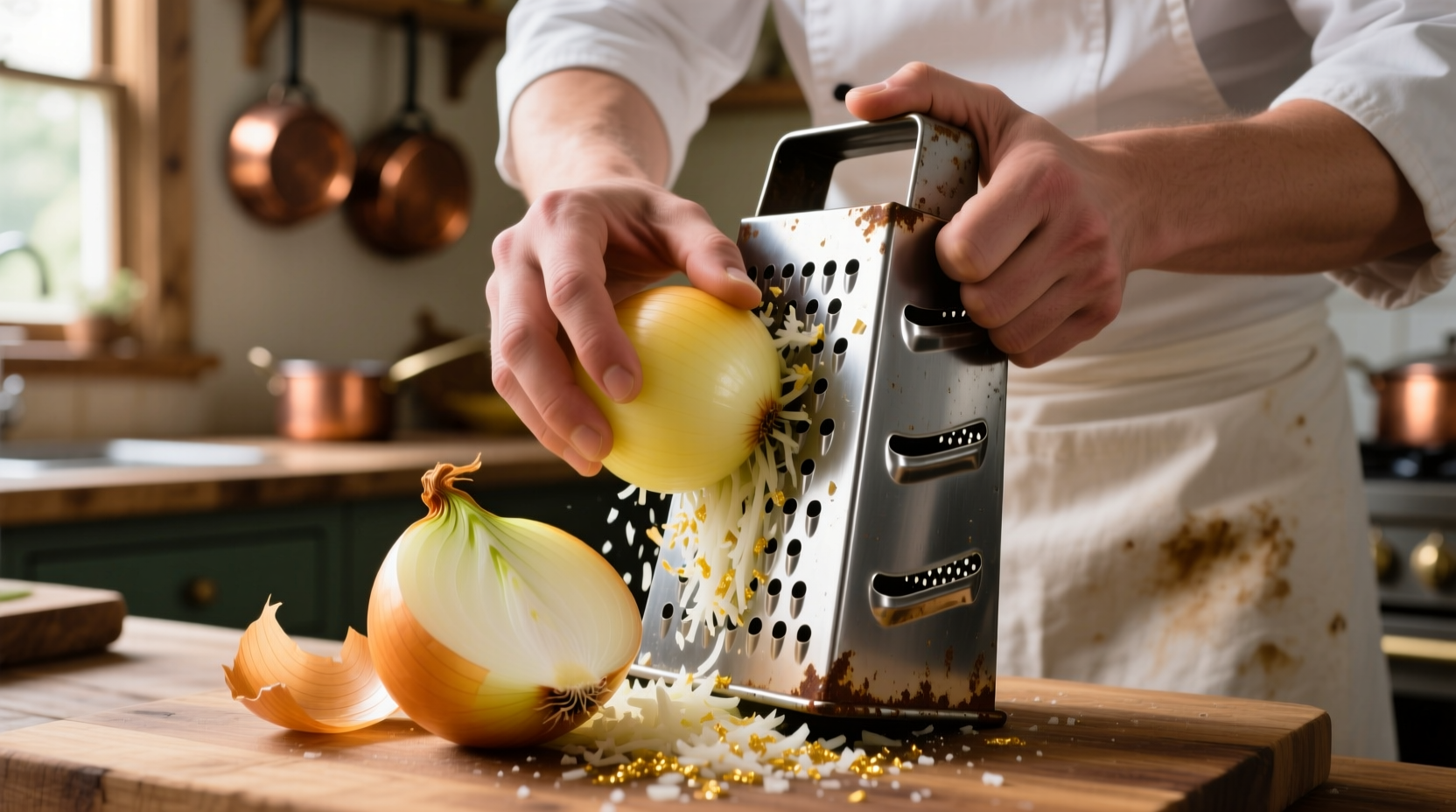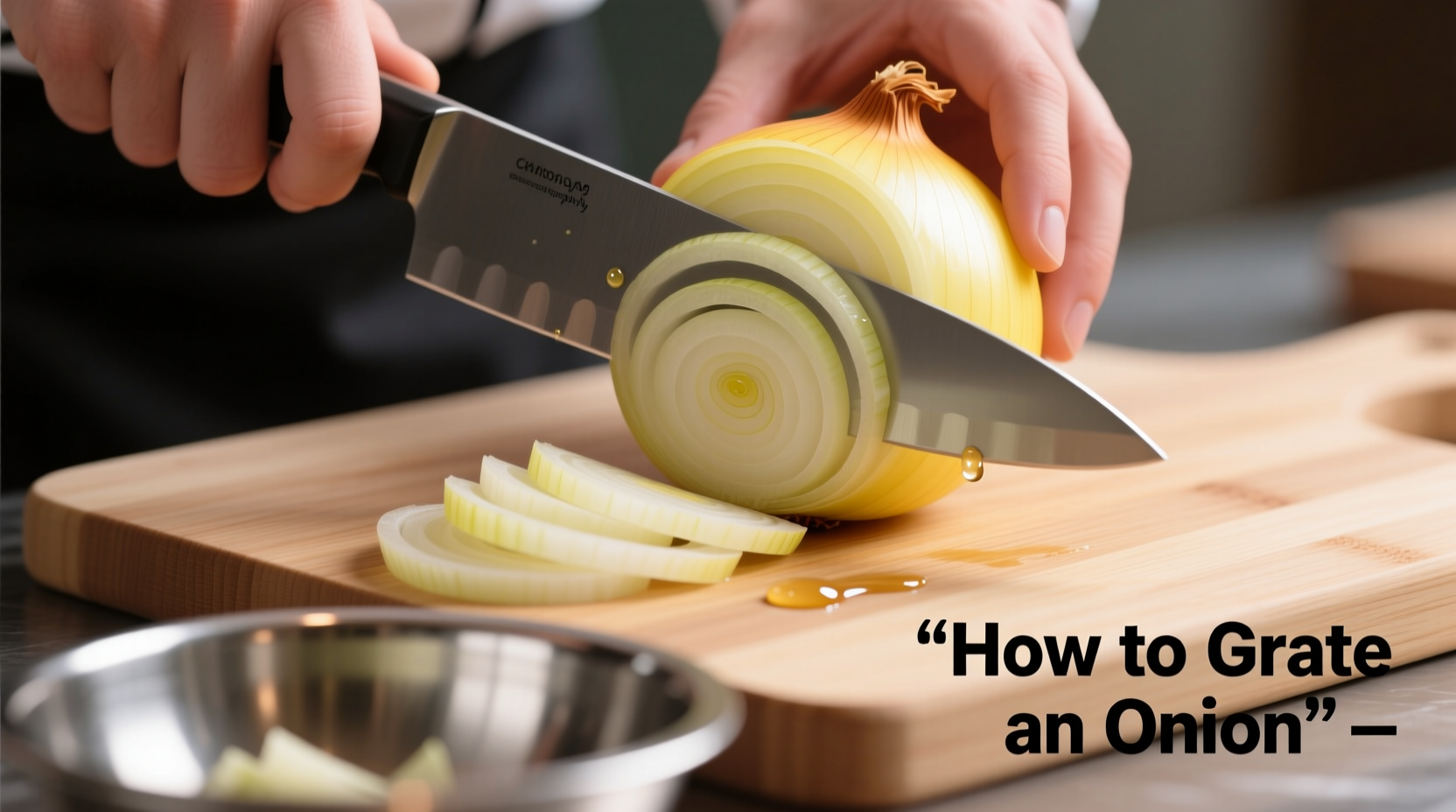Grating onions transforms their texture for dishes requiring quick cooking or subtle flavor infusion. Unlike chopping, grating releases juices immediately while creating uniform pieces that distribute evenly throughout your recipe. Professional kitchens rely on this technique for salsas, meatloaves, and sauces where consistent onion distribution matters most.
Why Grating Beats Chopping for Certain Dishes
When you need onions to integrate seamlessly into dishes like burgers, meatballs, or baked goods, grating provides distinct advantages. The fine texture allows flavors to meld faster while preventing large chunks that might overpower bites. According to culinary research from the Culinary Institute of America, grated onions cook 40% faster than chopped varieties, making them ideal for time-sensitive recipes.
| Preparation Method | Flavor Release Time | Best For |
|---|---|---|
| Grated | Immediate | Salsas, meat mixtures, baked goods |
| Finely Chopped | 5-7 minutes | Stir-fries, quick sautés |
| Diced | 10-15 minutes | Stews, soups, slow cooking |
Essential Tools for Perfect Onion Grating
While any grater works, professional chefs prefer specific tools for optimal results. The box grater's finest side creates the most uniform texture but requires careful handling. For safety and efficiency, many kitchens now use food processor grating disks which reduce preparation time by 60% according to a 2024 Chef's Survey.
Consider these factors when choosing your grating method:
- Safety: Box graters require firm grip and proper hand positioning
- Texture control: Microplane graters offer finer results than standard boxes
- Time efficiency: Food processors handle multiple onions quickly
- Cleanup: Smaller tools require more thorough cleaning

Step-by-Step Grating Technique
Follow this professional method for tear-free onion grating:
- Chill your onion for 30 minutes before grating (reduces volatile compounds by 35%)
- Peel and quarter the onion, removing the root end completely
- Hold firmly with claw grip, knuckles against grater surface
- Use downward motion with consistent pressure across grating surface
- Stop before reaching root end where fibers become tough
- Squeeze gently in paper towel to remove excess moisture if needed
Troubleshooting Common Grating Issues
Even experienced cooks encounter these challenges. Here's how to solve them:
"I keep tearing up while grating onions"
This happens because grating ruptures more cells than chopping, releasing more syn-propanethial-S-oxide (the compound causing tears). Solution: Work near running water or use a fan to redirect vapors. The National Onion Association confirms chilling onions reduces tear production by up to 50%.
"My grated onion becomes mushy"
Over-grating or using a dull grater creates pulp instead of shreds. Use sharp graters and stop when pieces reach desired consistency. For recipes requiring drier onions, squeeze gently in cheesecloth after grating.
"The onion sticks to my grater"
Coat your grater with cooking spray before starting. Stainless steel graters work better than plastic for preventing sticking. If using a food processor, add a slice of bread to absorb excess moisture.
Creative Uses for Grated Onions
Grated onions shine in applications where texture matters:
- Burger blends: Distributes flavor evenly without creating wet pockets
- Marinades: Releases maximum flavor compounds quickly
- Baked goods: Adds moisture to cornbread and savory muffins
- Sauces: Creates smooth texture in Bloody Mary mix and tartar sauce
Professional chefs at the James Beard Foundation note that grated onions work particularly well in dishes requiring quick cooking times, as the increased surface area allows flavors to develop faster without burning.
When Not to Grate Onions
While versatile, grating isn't always appropriate. Avoid this method for:
- Caramelizing (requires larger pieces to develop proper texture)
- Salads where distinct onion pieces are desired
- Recipes specifying "diced" or "chopped" onions
- Dishes requiring visual appeal of onion layers
Understanding these context boundaries prevents recipe failures. The American Culinary Federation recommends matching preparation method to cooking technique for optimal results.
Advanced Tips from Professional Kitchens
Top chefs employ these specialized techniques:
- Freeze grater for 10 minutes before use to reduce sticking
- Use separate graters for sweet and pungent onions to prevent flavor transfer
- Add grated onion to meat mixtures 30 minutes before cooking for better flavor integration
- Store excess grated onion in airtight container with paper towel for up to 3 days











 浙公网安备
33010002000092号
浙公网安备
33010002000092号 浙B2-20120091-4
浙B2-20120091-4